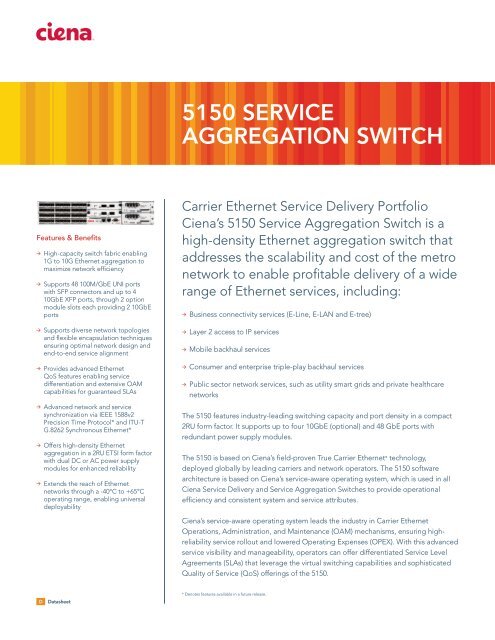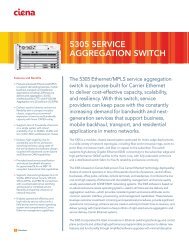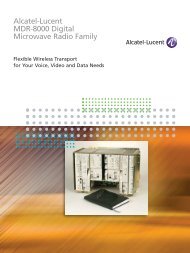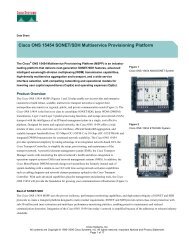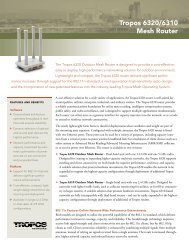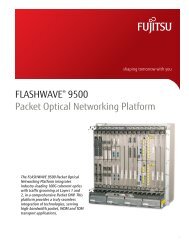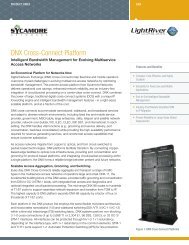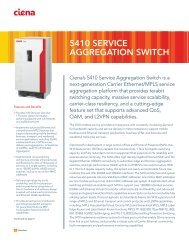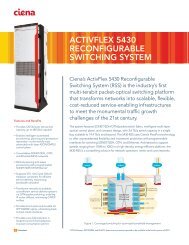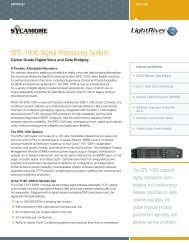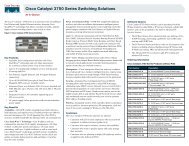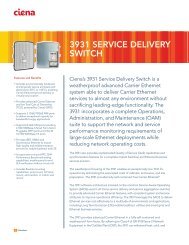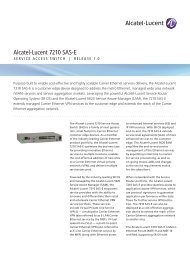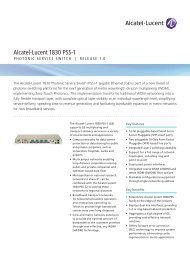Ciena 5150 Service Aggregation Switch datasheet - LightRiver ...
Ciena 5150 Service Aggregation Switch datasheet - LightRiver ...
Ciena 5150 Service Aggregation Switch datasheet - LightRiver ...
You also want an ePaper? Increase the reach of your titles
YUMPU automatically turns print PDFs into web optimized ePapers that Google loves.
<strong>5150</strong> SERVICEAGGREGATION SWITCHFeatures & Benefits> High-capacity switch fabric enabling1G to 10G Ethernet aggregation tomaximize network efficiency> Supports 48 100M/GbE UNI portswith SFP connectors and up to 410GbE XFP ports, through 2 optionmodule slots each providing 2 10GbEports> Supports diverse network topologiesand flexible encapsulation techniquesensuring optimal network design andend-to-end service alignment> Provides advanced EthernetQoS features enabling servicedifferentiation and extensive OAMcapabilities for guaranteed SLAs> Advanced network and servicesynchronization via IEEE 1588v2Precision Time Protocol* and ITU-TG.8262 Synchronous Ethernet*> Offers high-density Ethernetaggregation in a 2RU ETSI form factorwith dual DC or AC power supplymodules for enhanced reliability> Extends the reach of Ethernetnetworks through a -40°C to +65°Coperating range, enabling universaldeployabilityCarrier Ethernet <strong>Service</strong> Delivery Portfolio<strong>Ciena</strong>’s <strong>5150</strong> <strong>Service</strong> <strong>Aggregation</strong> <strong>Switch</strong> is ahigh-density Ethernet aggregation switch thataddresses the scalability and cost of the metronetwork to enable profitable delivery of a widerange of Ethernet services, including:> Business connectivity services (E-Line, E-LAN and E-tree)> Layer 2 access to IP services> Mobile backhaul services> Consumer and enterprise triple-play backhaul services> Public sector network services, such as utility smart grids and private healthcarenetworksThe <strong>5150</strong> features industry-leading switching capacity and port density in a compact2RU form factor. It supports up to four 10GbE (optional) and 48 GbE ports withredundant power supply modules.The <strong>5150</strong> is based on <strong>Ciena</strong>’s field-proven True Carrier Ethernet ® technology,deployed globally by leading carriers and network operators. The <strong>5150</strong> softwarearchitecture is based on <strong>Ciena</strong>’s service-aware operating system, which is used in all<strong>Ciena</strong> <strong>Service</strong> Delivery and <strong>Service</strong> <strong>Aggregation</strong> <strong>Switch</strong>es to provide operationalefficiency and consistent system and service attributes.<strong>Ciena</strong>’s service-aware operating system leads the industry in Carrier EthernetOperations, Administration, and Maintenance (OAM) mechanisms, ensuring highreliabilityservice rollout and lowered Operating Expenses (OPEX). With this advancedservice visibility and manageability, operators can offer differentiated <strong>Service</strong> LevelAgreements (SLAs) that leverage the virtual switching capabilities and sophisticatedQuality of <strong>Service</strong> (QoS) offerings of the <strong>5150</strong>.DDatasheet* Denotes features available in a future release.
CoreMetro/<strong>Aggregation</strong>1GbEQ-in-Q10GbEQ-in-Q,10GbEQ-in-Q,MPLS/VPLS,PBB-TE,G.803210GbEQ-in-Q,1GbEQ-in-QFigure 1. <strong>5150</strong> Ethernet aggregationIn mobile backhaul applications, the <strong>5150</strong> providesutilize IEEE 1588v2 Precision Timing ProtocolEthernet to empower carriers to migrate toarchitectures with confidence that the network4G mobile technologies, such as Long-TermThe advanced design and service-rich architectureenables network operators to deploy reliableofferings that leverage the inherent elegancetechnology to generate maximum revenue.Additionally, the efficient architecture, extendedrange, and compact packaging design enablethe <strong>5150</strong> in a wide variety of physical environments,Ethernet aggregation exactly where maximumbandwidth and valuable optical fiber resourcesachieved. By coupling this deployment flexibilityof Ethernet encapsulation options supportedswitching architecture, the <strong>5150</strong> excels incarrier networks, both large and small.High Density Ethernet <strong>Service</strong> <strong>Aggregation</strong>The <strong>5150</strong> <strong>Service</strong> <strong>Aggregation</strong> <strong>Switch</strong> hasfeature capabilities to thrive in diverse operatorcreate a bandwidth-efficient aggregationenters the network core:> 1GbE> 10GbE service aggregationAccessthe abilitySynchronouspacketready to supportEvolution (LTE).of thescalableEthernettemperaturedeploymentprovidingefficiencymay bewith thethe virtualrange ofcapacity andnetworksbefore traffic> 1GbE >1GbE service aggregation with 10GbE deferral> Synchronous Ethernet service distributionAs Ethernet services extend farther into the access networkservice penetration grows, managing the scalability and costthe metro and core networks requires a highly efficientaggregation tier. The <strong>5150</strong> provides highdensity aggregationdrive bandwidth efficiency and squeeze maximum use out ofexpensive core router ports, dramatically reducing networkThe <strong>5150</strong> enables the recovery of valuable optical fiber in theaccess network. The ability to deploy high-density aggregationin a wide variety of physical environments ensures that operatorscan maximize the effectiveness of the Ethernet access network.Synchronization and TimingThe cost-effectiveness and versatility of Carrier Ethernet isdriving the convergence of services. Many services placetiming and synchronization requirements onto the Ethernetnetwork. The <strong>5150</strong> enables carriers to provide SONET/SDH-likeLayer 1 timing throughout the network via SynchronousEthernet. The <strong>5150</strong> also provides IEEE 1588v2 Packet TimingProtocol to distribute timing through mixed networks andarchitect an LTE-ready network where both frequency andphase are required.> IEEE 1588v2 Precision Time Protocol*> ITU-T G.8262 Synchronous Ethernet*> Stratum-3E HoldoverCarrier-Class QoSThe <strong>5150</strong> implements carrier-class MEF-14-compliant QoSmechanisms that enable the delivery of a wide range of traffictypes and rates over a single access infrastructure withoutdegradation.> Rich classification of traffic flows based on Layer 1 throughLayer 4 parameters, including physical port, MAC address,VLAN tag, IP address, and L4 port address> Flexible priority resolution for Class of <strong>Service</strong> mappingbased on priority settings contained in VLAN, MPLS, PBB-TEtags, and IP packet headers> Sophisticated Ingress metering for Committed InformationRate (CIR), Excess Information Rate (EIR), Committed BurstSize (CBS), and Excess Burst Size (EBS) service delivery> Two-rate Three-Color Marking (trTCM) and Random EarlyDrop (RED) for sophisticated congestion handlingandofPBB-TEto1GbEQ-in-Qcosts.PBB-TEnewtoandpureis<strong>5150</strong>andofofofrangebya widethetolayer* Denotes features available in a future release.2
Proven <strong>Service</strong>-Aware Operating System<strong>Ciena</strong>’s service-aware operating system is used in all <strong>Ciena</strong><strong>Service</strong> Delivery and <strong>Service</strong> <strong>Aggregation</strong> <strong>Switch</strong>es to deliverconsistent benefits across all Ethernet access and aggregationapplications, including:> Rapid implementation of the latest advances in Ethernettechnologies, as well as new services and standardsproposed by the IEEE, the IETF, and MEF> Interoperability with Ethernet equipment from other vendors> Improved efficiency and cost savings resulting from acommon deployment and service provisioning model> <strong>Service</strong> offering ubiquity, permitting rapid rollout of newservices across the entire networkThe <strong>5150</strong> software is designed to deliver plug-and-playactivation and supports an advanced automatic activationfeature that can upgrade the default settings to deployoperator-specific configurations, reducing new platformintegration time and enable network operators to extendservices to new subscribers rapidly and efficiently.Ethernet Transport OptionsThe <strong>5150</strong> gives operators a variety of Carrier Ethernet transportoptions, including 802.1q VLANs, 802.1ad Provider VLANs (Q-in-Q);MEF Ethernet connections including Ethernet Virtual Private Line/LAN/Tree services; MPLS Virtual Circuits; VPLS/H-VPLS Layer 2VPNs; and PBB-TE Tunnels with PBB-TE Ethernet Virtual Circuits.The <strong>5150</strong> supports interworking between Q-in-Q VLANs, MPLSVirtual Circuits, VPLS/H-VPLS L2VPNs, and PBB-TE connectionswith a sophisticated virtual switching architecture for completeservice flexibility and optimal utilization of network resources.<strong>Ciena</strong> is an industry leader in the implementation of PBB-TE,which extends Ethernet to provide carrier-grade transport overMetro and Wide Area Networks.The <strong>5150</strong>’s advanced PBB-TE feature set delivers a reliable,resilient, and cost-effective connection-oriented transportsolution ideal for delivering a variety of new services to afast-growing customer base. Dual homing, built-in backuptunnels, and 50 ms failover capabilities ensure rapid anddeterministic recovery of critical services.Based on extensions to current Ethernet standards, PBBTEenabledproducts maintain compatibility with existing Ethernetdeployments. This broad compatibility enables the <strong>5150</strong> todeliver a wide range of connectivity services with guaranteedQoS, while interoperating seamlessly with an installed base ofmulti-vendor switching and routing systems that do not supportPBB-TE. Because the advantages of PBBTE are available withoutmajor changes to existing network equipment or architectures,the <strong>5150</strong> offers superior investment protection.The <strong>5150</strong> offers a comprehensive set of MPLS, VPLS, andH-VPLS features that support resilient MPLS L2VPNs andenable service providers to offer MPLS-based connectivityservices on metro Ethernet networks, extending thefunctionality and scalability of MPLS core networks.These MPLS features include:> MPLS Pseudowire Emulation Edge-to-Edge (PWE3), whichsupports MPLS Virtual Private Wire <strong>Service</strong>s (VPWS),sometimes called MPLS Virtual Leased Lines. VPWS enablesthe provisioning of MPLS-based Ethernet Virtual Circuits(EVCs) and supports MPLS-based Ethernet Private Line andEthernet Virtual Private Line services> Virtual Private LAN <strong>Service</strong>s (VPLS) and Hierarchical-VPLS(H-VPLS) based on MPLS Label <strong>Switch</strong>ed Paths (LSPs) andMPLS Virtual Circuits (VCs). <strong>5150</strong> VPLS capabilities supportLayer 2 VPNs that are based on Ethernet transport, with thebenefits of an MPLS/VPLS control plane. This control planeincludes Label Distribution Protocol (LDP) for VPLS VCsignaling; OSPF-TE and IS-IS-TE for MPLS Tunnel Routes;and RSVP-TE for the establishment of the LSPs thatconstitute the VPLS> MPLS label edge router functionality, which enables the <strong>5150</strong>to function as a VPLS/H-VPLS Provider Edge switch (PE-rs)and as an H-VPLS MTU-s customer edge switch. The <strong>5150</strong>also supports H-VPLS Dual Homing, which providesresiliency by enabling spoke connections from an MTU-s totwo different PE Hub switches. For additional flexibility,H-VPLS spoke connections can be implemented using MPLSpseudowires (VCs), Q-in-Q Ethernet VLAN Virtual Circuits,Ethernet Private Lines, Ethernet Virtual Private Lines, andPBB-TE service instances> MPLS tunnel groups can be configured on the <strong>5150</strong> tosupport LSP redundancy> MPLS FRR further enhances resiliency for MPLS/VPLS servicesby enabling LSPs to be restored within 50 ms in case ofphysical or logical link failure> MPLS OAM capabilities include LSP Ping and LSP Traceroute,which can be used to verify the LSP status and topology3
Carrier-Class Ethernet OAMThe <strong>5150</strong> supports a rich set of OAM features defined in thelatest versions of IEEE, ITU, and IETF standards, including:> IEEE 802.3ah Ethernet in the First Mile (EFM) physical layerOAM, including link events and remote loopback> IEEE 802.1ag CFM, including MAC Ping/Traceroute andContinuity Check> ITU-T Y.1731 Ethernet OAM, including performancemonitoring> 802.1AB Link Layer Discovery Protocol (LLDP)> IETF RFC 5618 Two-Way Active Management Protocol(TWAMP) with complete sender and receiver capabilitiesThese capabilities enable the <strong>5150</strong> to monitor the status ofsystem and network links; measure the performance ofcustomer Ethernet <strong>Service</strong>s; confirm that link and servicethroughput and quality conform to SLAs; and distribute thismanagement information across point-to-point, pointtomultipoint,and multipoint-to-multipoint connections.Ethernet <strong>Service</strong>s Manager<strong>Ciena</strong>’s Ethernet <strong>Service</strong>s Manager (ESM) is a groundbreakingcarrier-grade, automated service activation, creation, andmanagement platform for managing a service provider’sservice delivery and service aggregation networks. ESM letsusers build and deploy large-scale Carrier Ethernet networksquickly and easily; cuts time to market for new services;accelerates service revenue; maximizes service availability;assures service quality; leverages existing systems; and enablessubscriber-managed services. All of these functions cut totalcost of ownership and reduce time to market and revenue.The ESM also paves the way to implement new, yetunimagined services quickly and cost-effectively forincreased revenue and competitiveness.Technical InformationInterfaces48 x 100/1000M SFP UNI ports2 x 10GbE Module Slots, 2 x 10GbE XFP portsper module1 x 10/100/1000M RJ-45 Management port1 x Console Port (RJ-45, EIA-232)5 x External Alarm Inputs (DE-15)EthernetIEEE 802.3 EthernetIEEE 802.3u Fast EthernetIEEE 802.3z Gigabit EthernetIEEE 802.1D MAC BridgesIEEE 802.1Q VLANs - Including .1p PriorityIEEE 802.1ad Provider - full S-VLAN rangeVLAN tunneling (Q-in-Q) for TransparentLAN <strong>Service</strong>s (TLS)Per VLAN MAC Learning ControlPer-Port MAC Learning ControlIEEE 802.1w Rapid Spanning Tree (RSTP)- now in .1DIEEE 802.3ad Link <strong>Aggregation</strong> ControlProtocol (LACP)ITU-T G.8032 Ethernet Rings Protection<strong>Switch</strong>ingJumbo Frames to 9216 bytesLayer 2 Control Frame TunnelingQuality of <strong>Service</strong>8 Hardware Queues per PortCommitted and Excess Information Rate(CIR and EIR)Classification based on IEEE 802.1D priorityClassification based on VLAN, source port,destination port, TCP/UDP portClassification based on IP Precedence and IPDSCPLayer 2, 3, 4 Quality of <strong>Service</strong>Ingress metering per-portIngress metering per-port per-CoSIngress metering per-port per-VLANUp to 512 Ingress Meters per portUp to 4096 Ingress Meters per systemC-VLAN Priority to S-VLAN Priority MappingS-VLAN Priority based on C-VLAN IDPer-VLAN Classification, Metering, andStatisticsPer-port per-VLAN QoS with CIR and EIR trafficon Egress QueuesMPLS/VPLS*MPLS Pseudowire Emulation Edge-to-Edge(PWE3)MPLS Virtual Private Wire <strong>Service</strong> (VPWS)VPLS (Virtual Private LAN <strong>Service</strong>) andHierarchical VPLS (H-VPLS)Provider Edge (PE-s) Functionality for VPLSand H-VPLSVPLS with multiple VPLS Mesh Virtual CircuitsH-VPLS with Hub and Spoke Virtual CircuitsMTU-s Functionality for H-VPLS deploymentMTU-s Multihoming (redundant VCs todifferent PE-s switches)MPLS Virtual Circuit as H-VPLS spoke VirtualCircuitPBB-TE <strong>Service</strong> Instance as H-VPLS spokeVirtual CircuitQ-in-Q Ethernet Virtual Circuit as H-VPLSspoke Virtual CircuitMPLS Label <strong>Switch</strong> Path (LSP) Tunnel GroupsMPLS Label <strong>Switch</strong> Path (LSP) Tunnel RedundancyLayer 2 Control Frame Tunneling over MPLSVirtual CircuitsRSVP-TE (for MPLS Tunnel Signaling)OSPF-TE (for MPLS Tunnel Routes)IS-IS-TE (for MPLS Tunnel Routes)LDP & Targeted LDP (for VPLS VC signaling)MPLS Fast ReRoute (via RSVP-TE)MPLS Performance MonitoringLSP PingLSP Traceroute* Denotes features available in a future release.4
Technical Information continuedCarrier Ethernet OAMIEEE 802.1ag Connectivity Fault Management(CFM)IEEE 802.3ah Ethernet in the First Mile (EFM)IEEE 802.1AB Link Layer Discovery Protocol(LLDP)ITU-T Y.1731 Ethernet OAM - PerformanceMonitoringTWAMP Responder and Receiver (RFC 5618)TWAMP SenderTWAMP +/- 1ms timestamp accuracyDying Gasp with Syslog and SNMP TrapsPBB-TE (Provider Backbone Bridging-TrafficEngineering)IEEE 802.1Qay PBB-TEIEEE 802.1ah PBB frame formatPBB-TE Multi-homed Protection FailoverIEEE 802.1ag CFM for PBB-TE TunnelsIEEE 802.1ag CFM for PBB-TE <strong>Service</strong>PBB-TE Full B-VID & I-SID address rangesPBB-TE Tunnel & <strong>Service</strong> meteringMulticast ManagementIGMPv2 Snooping (RFC 2236)IGMP DomainsIGMP Message FilteringIGMP Inquisitive LeaveBroadcast/Multicast Storm ControlUnknown Multicast FilteringWell-known Protocol ForwardingNetwork ManagementEnhanced CLI CLI-based configuration filesSNMP v1/v2c/v3 SNMPv3 Authentication andMessage EncryptionSNMP MIB II (RFC 1213)Bridge MIB (RFC 1493)Ethernet-like Interface MIB (RFC 1643)MIB II interfaces (RFC 1573)RMON MIB (RFC1757) - inc. persistentconfigurationRMON II (RFC 2021) and RMON StatisticsPer-VLAN StatisticsRADIUS Client and RADIUS AuthenticationTACACS + AAADHCP Client (RFC 2131)NTP Client (RFC 1305)DNS Client (RFC 1035)Telnet ServerSecure File Transfer Protocol (SFTP)Trivial File Transfer Protocol (TFTP)Secure Shell (SSHv2)Syslog with Syslog AccountingPort State MirroringLocal Console PortComprehensive Management via Ethernet<strong>Service</strong>s ManagerRemote Autoconfiguration: FTP, TFTP, SFTPSoftware download/upgrade: FTP, TFTP, SFTPMAC Address Table Capacity32,000 MAC addresses256,000 MAC addresses product option*Timing SynchronizationIEEE 1588v2 Precision Time Protocol*ITU-T G.8262 Synchronous Ethernet*<strong>Service</strong> SecurityLayer 2, 3, 4 Protocol FilteringBroadcast ContainmentUser Access RightsPer-port or per-VLAN <strong>Service</strong> Access ControlHardware-based DOS Attack PreventionHardware-based Access Control Lists (ACLs)Power RequirementsDC Input: -48, -24, +24 VDC (nominal)AC Input: 100V, 240V AC (nominal)AC Frequency: 50/60 HzMaximum Power Input: 300 WAgency ApprovalsSafety: European Union, CE mark (Declarationof Conformity); UL 60950l IEC 60950 (CB);EN 60950; CAN/CSAC22.2 No. 60950-00(Canadian Safety)Emissions: FCC Part 15:1998 Class B; EN55022(1994) Class B (with amendments A1 andA2); EN61000-3-2 (1995) Harmonic currentemissions; EN61000-3-3 (1995) Voltagefluctuations and flickerTelecom: FCC Part 68: Subpart D; IndustryCanada (CS-03, Issue 8, Part 1)Environmental: WEEE 2002/96/EC RoHS2002/95/ECImmunity: ETSI/EN 300 386:V1.3.2 (2003-05)(EU Telecommunication Emissions andImmunity)Laser Safety: CDRH Letter of Approval (USFDA Approval); Europe: EN60825- 1:1994+A11:1996+A2:2001 (European Safety ofLasers)Environmental CharacteristicsOperating Temperature: -40°F to +149°F(-40°C to +65°C)Storage Temperature: -40°F to +158°F (-40°Cto +70°C)Relative Humidity: 5% to 90% (noncondensing)Physical CharacteristicsDimensions: 17.5” (W) x 10.0” (D) x 3.5 “ (H);444.5mm (W) x 254.0mm (D) x 89.0mm (H)Weight: 24 lbs; 10.9 kg* Denotes features available in a future release.<strong>Ciena</strong> may from time to time make changes to the products orspecifications contained herein without notice. © 2011 <strong>Ciena</strong> Corporation.All rights reserved. DS142 7.2011Networks that changethe way you compete.1201 Winterson RoadLinthicum, MD 210901.800.207.3714 (US and Canada)1.410.865.8671 (outside US and Canada)+44.20.7012.5555 (international)www.ciena.com


